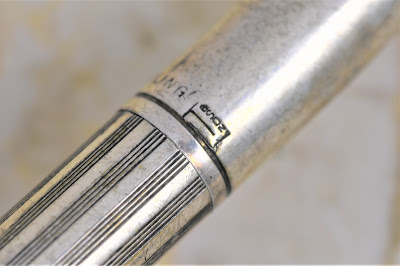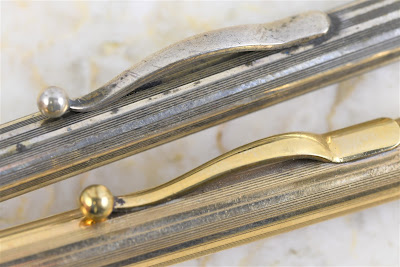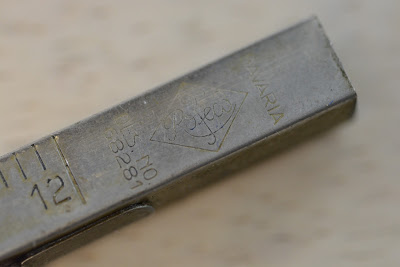This article has been edited and included in The Leadhead's Pencil Blog Volume 6, now on sale at The Legendary Lead Company. I have just a few hard copies left of the first printing, available here, and an ebook version in pdf format is available for download here.
If you don't want the book but you enjoy this article, please consider supporting the Blog project here.
Hey -- you have to give this rural Ohioan some props for knowing it was Japanese, in a part of the world where if it isn’t written in ‘Merican, it must just be from “over there somewhere.” I wish I could say I’m more cosmopolitan than the average Midwesterner, but the truth is that I cheated. I already knew where it was from:
When this Kanoe school set came up for auction, it was one of those things I used to say didn’t fit into my collection at all, but foreign pencils tend to nibble around the borders of the museum when one thing leads to another.
In this case, it’s been a number of years coming, beginning with a Brown & Bigelow-marked pencil in an unusual trapezoidal shape (originally posted back in March, 2013 - the article is in The Leadhead’s Pencil Blog Volume 2, page 106). Both the internal and external elements of this Brown & Bigelow were later appropriated by both German and Japanese manufacturers, most prevalently on the “Peace” pencils made in postwar Japan. In this next photo, from here at the Blog back in 2017, the Brown and Bigelow is at the top, immediately under which is a familiar “Peace” pencil:
Poor Joe Nemecek – he’s probably gone through three computer monitors by this point, because he says he throws a brick at the screen every time I bring these up. Given their odd shape, it’s easy in online auctions to mistake them for other (and admittedly better) things, even though in that last article in 2017 I unveiled one along these lines marked Sarastro, the company which also made overlays for Mont Blanc (the full article is still online at https://leadheadpencils.blogspot.com/2017/08/and-now-for-some-overdue-respect.html).
Hang in there Joe – and all of you who are similarly inclined – that’s as far as I delve into that subject . . . for now (dum dum dummmmmmm.....). My point in bringing these up again is that the “Peace” pencils were made by ... drum roll ... Kanoe. I’ve mentioned that connection a couple times here at the blog, and at one point I nabbed a crappy online seller’s picture of a boxed example that I just . . . can’t . . . find right now to drive that particular point home.
That’s how this Kanoe set wormed its way into my collection.
Both pencils are marked “Kanoe Peace” on the clip, and they are freakishly slim given the 2.0mm leads for which they were designed. Also in the box were two containers of leads, one with red leads and other one with black ones, with a nifty rectangle of sandpaper built into the lid so you have something to sharpen up your leads with.
There’s also an odd little pair of tweezers. I dunno . . . maybe that’s got something to do with this, maybe that’s just some random little thing that fit conveniently in an unrelated box at some point over the last seventy years or so. I’ve never tweezed a pencil personally, but if I ever feel the need, at least now I’m ready.
Let’s look a little closer at those lead containers. At one end, not surprisingly, they are stamped “Kanoe”:
And at the other . . .
well, that’s the reason I had to ask the online community for a bit of help. A quick post, and within an hour Lee Han had the answer for me . . . it reads, “Patent Pending.”
The title of this article wasn’t about having to dangle that bit of Japanese out there asking for a translation to get people to tune in today. It’s got me wondering why just these words were stamped on the lead containers in Japanese when this Kanoe set was manufactured in post-War Japan expressly for the American market. People stamp “Patent Pending” on their products as a warning, to put others on notice that the manufacturer is in the process of seeking patent protection. Would-be copiers beware: regardless of whether you copy this before or after the patent is ultimately issued, an infringer is an infringer and this legend says the patent holder will hold you accountable.
So why stamp such a warning in Japanese? In 1950s America, few people other than those of Japanese descent would be able to read it (heck, this Ohioan in 2020 had no clue what it said).
The only explanation I can conceive is that this warning wasn’t for American companies, but for other Japanese companies. That’s kind of interesting to me that Japanese firms were more worried about each other than they were about the Americans to whom these products were being supplied.


















































